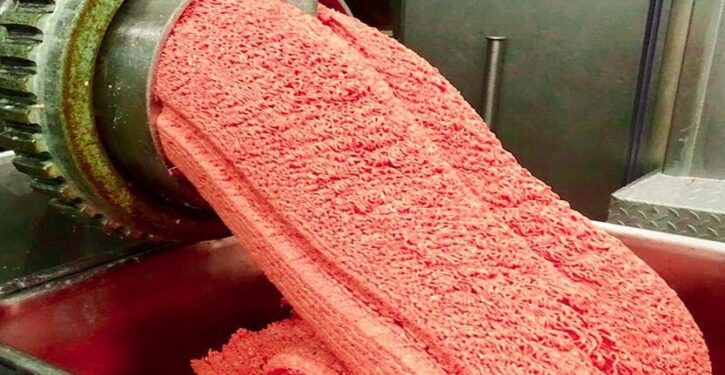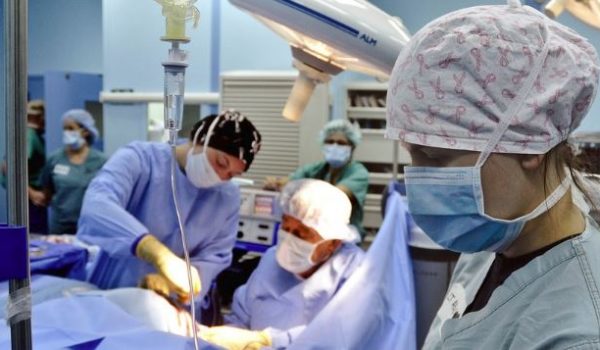
“Great news everyone! There’s now a form of artificial meat that’s extruded in a continuous, undead tube, and it grows by itself because scientists gave it cancer,” exclaims Lance Parkin.
Free Thought Blogs reports:
Scientists have modified muscle cells in culture so that they produce their own growth factors. This is a major cost reduction, because now you won’t need to constantly supplement your vat of muscle cells with a relatively expensive reagent:
Cellular agriculture – the production of meat from cells grown in bioreactors rather than harvested from farm animals – is taking leaps in technology that are making it a more viable option for the food industry. One such leap has now been made at the Tufts University Center for Cellular Agriculture (TUCCA), led by David Kaplan, Stern Family Professor of Engineering, in which researchers have created bovine (beef) muscle cells that produce their own growth factors, a step that can significantly cut costs of production.
Growth factors, whether used in laboratory experiments or for cultivated meat, bind to receptors on the cell surface and provide a signal for cells to grow and differentiate into mature cells of different types. In this study published in the journal Cell Reports Sustainability, researchers modified stem cells to produce their own fibroblast growth factor (FGF) which triggers the growth of skeletal muscle cells – the kind one finds in a steak or hamburger.
Keep in mind that this works for cultured meat cells, which is completely different from the artificial meat made from plants that you can buy in stores right now. I have a few reservations about it.
This is basically a tool to remove a regulatory limit on muscle growth. When this happens in vivo, we call it cancer. I suspect the marketing department will balk at labeling it “tumor meat”.
The technique amplifies one cell type. Edible meat has texture and is made up of a mix of cell types, fat and connective tissue. This is a way to make large quantities of something that is equivalent to ‘pink slime’ or, as the marketers call it, ‘lean finely textured beef.’ We already do this! I guess it’s a good thing to be able to produce large quantities of protein in the form of ‘pink slime’ more cheaply, and without the need to slaughter animals to do it.
This is just one form of lab-grown meat. Crunchbase reports that investors are pouring more than a billion dollars each year into startups “working on cell-cultured meat and other cell-cultured meat alternatives.” But “for now, meat grown from animal cells is only available in the U.S. in very limited quantities at two high-end restaurants. Chicken is the first proof-of-concept product, and while the taste is familiar, the texture is a work in progress. It remains to be seen if the technology to ‘grow’ meat at scale will prove economical — and if consumers will welcome the results.”
As Axios explains,
To manufacture cultivated meat, animal cells are placed in a large steel vessel called a bioreactor — or “cultivator” — and fed for at least two weeks with a variety of nutrients, which help the cells grow and differentiate similarly to how they would in a living animal. Depending on how the cells are nurtured, the product can emerge in the consistency of soup or pancake batter — to be formed into a sausage or nugget — or in a filet-like sliver of meat. “Instead of raising a chicken, we are raising chicken cells, letting the cells do what they naturally do, which is grow,” said Valeti, a cardiologist who founded Upside Foods in 2015. Unlike at a farm, “we don’t have fecal matter; we do not have the skin and the hair and the bones” of the animal. It’s “significantly more efficient than growing an entire animal and eating only a part” of it, he claims.
Researchers are also working on lab-grown meat that has less impact on the environment than raising livestock. A company recently re-created woolly mammoth meatballs.
Ten years ago, scientists came up with the world’s first lab-grown beef burger. Last August, Bloomberg News reported that “a Dutch startup is luring a dwindling pool of investor funds with stem-cell technology that can rapidly grow slaughter-free sausages,” reports Bloomberg News.
Lab-grown beef might be better for the environment than naturally-raised beef. But that is probably not true for other meats that are more efficient to produce naturally, such as chicken. A study concluded that because of the energy consumption needed to scale up cultured meat, its carbon footprint could be several times that of conventional chicken.
Guinea pigs are a much more efficient source of protein, per acre, than cattle, generating four times as much meat per acre. Guinea pigs also generate less greenhouse gas emissions per pound of meat.



